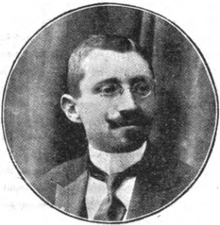Jacques Sayabalian
Jacques Sayabalian | |
|---|---|
 | |
| Born | Jacques Sayabalian (Paylag) June 1880 |
| Died | 1915 |
| Nationality | Armenian |
| Occupation(s) | writer and poet |
Jacques or Jack Sayabalian (Paylag) (Armenian: Ժագ Սայապալեան (Փայլակ); June 1880 – 1915) was an Armenian writer and poet who was also an interpreter for the British Consul in Konya between 1904 and 1909, then vice-consul for a year and a half. He was also a member of the Armenian National Assembly representing his birthplace of Konya. After 1909, he became a journalist in Constantinople. During the Armenian genocide, Sayabalian was deported to Ankara and then killed.
Life[edit]
Jacques Sayabalian was born in Konya in the Konya Vilayet of the Ottoman Empire in June 1880.[1] His father was the governor of the province of Konya.[2][3] Sayabalian received his early education at a local school in Konya.[4] In 1896, he went to Constantinople where he attended the prestigious Reteos Berberian Armenian school.[1][4] Sayabalian continued his education at the American College located in Izmir for two years.[1] A fluent speaker of English, after finishing his studies from the American College in 1904, Sayabalian returned to Konya where he became an interpreter for the British Consul.[4] After working as an interpreter for 5 years, Sayabalian returned to Constantinople where he began writing for various local Armenian newspapers and journals.[1] He became a member of the Armenian National Assembly representing Konya.[4] He also contributed to local Armenian newspapers such as the Surhantag and Massis.[1] When Sayabalian contributed to the Massis newspaper, he signed his poems and stories with the pen-name "V".[1]
Death[edit]
Jacques Sayabalian was one of the Armenian leaders deported during the Armenian genocide. On 24 April 1915, Sayabalian was arrested and sent via train to Çankırı, a village located in the interior provinces of the Ottoman Empire.[5] He was then deported to Ankara where he was murdered.[6][7] His remains are yet to be found.[1]
See also[edit]
References[edit]
- ^ a b c d e f g "BASIN DA GEÇMİŞİNE SANSÜR UYGULUYOR". Haber Ruzgari (in Turkish). 2010-07-24. Archived from the original on 2013-10-19.
- ^ ÖZCAN, Mustafa (2012-09-19). "VARTAN İHMALYAN". Anadolu Manset (in Turkish). Archived from the original on 2013-12-08. Retrieved 2013-10-18.
- ^ "Jak İhmalyan" (in Turkish). Biyografi.net.
- ^ a b c d Lapçinciyan, Teotoros (1919). Houshartsun nahadoug medavoraganouti (in Armenian). p. 24.
- ^ "Soykırımdan geriye kalan sözler". Etkin Haber Ajansi. 23 April 2012. Archived from the original on 24 September 2015. Retrieved 18 October 2013.
- ^ Sevag, Grigoris (2010). Armenian Golgotha : a memoir of the Armenian genocide, 1915-1918 (1st Vintage Books ed.). New York: Vintage Books. ISBN 978-1400096770.
- ^ Kazarian, Haigazn K. (Autumn 1971). "Opening of the Turkish Genocide of 1915-1918: Arrest and Murder of the Armenian Intellectuals". The Armenian Review. 24 (3): 23. ISSN 0004-2366.
